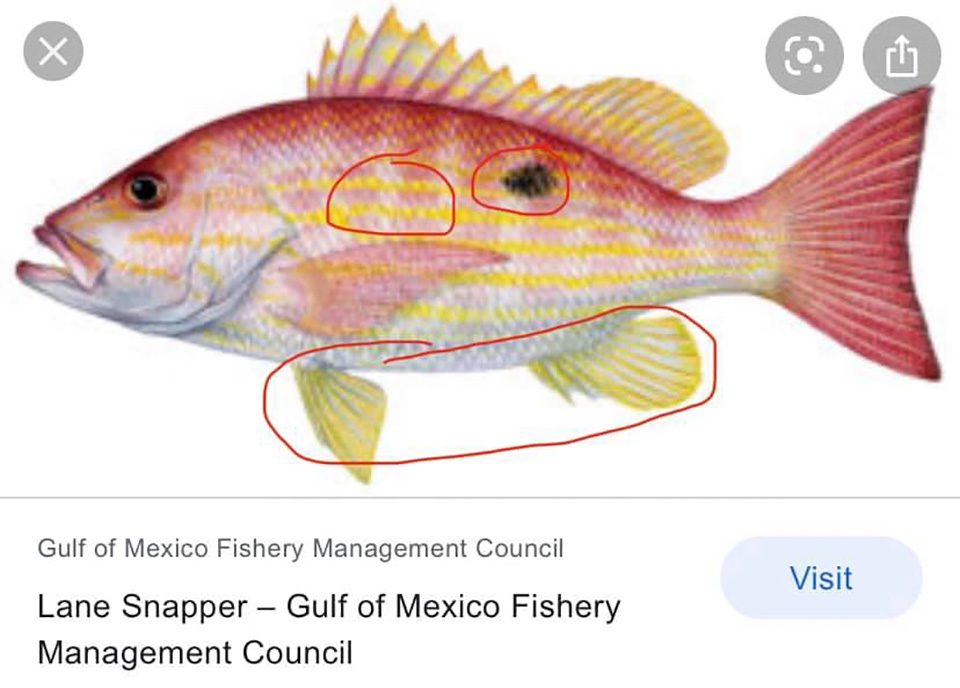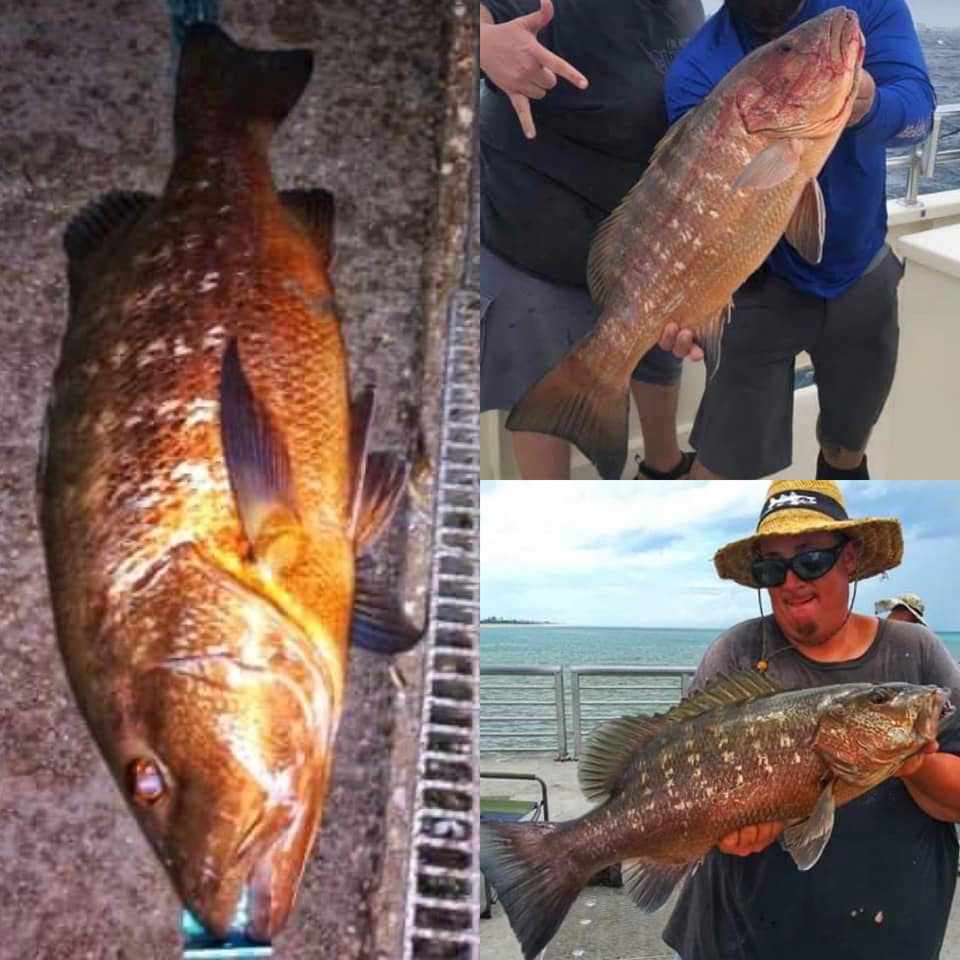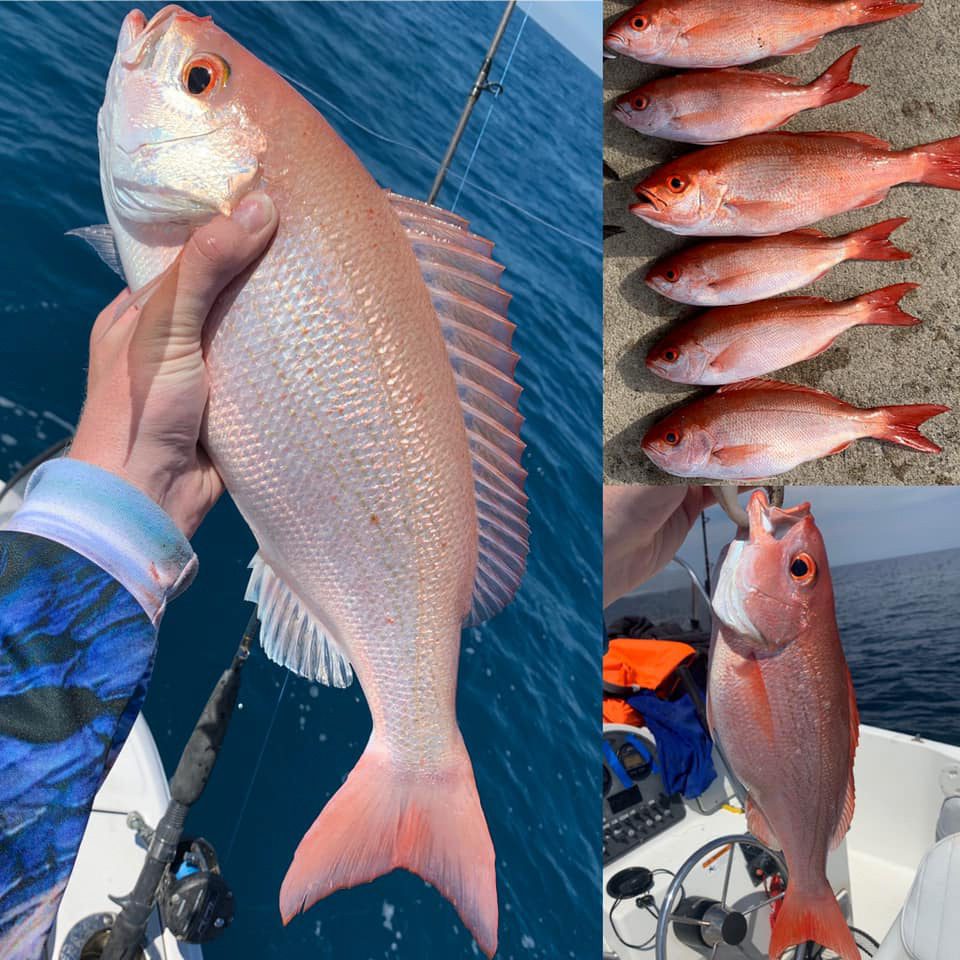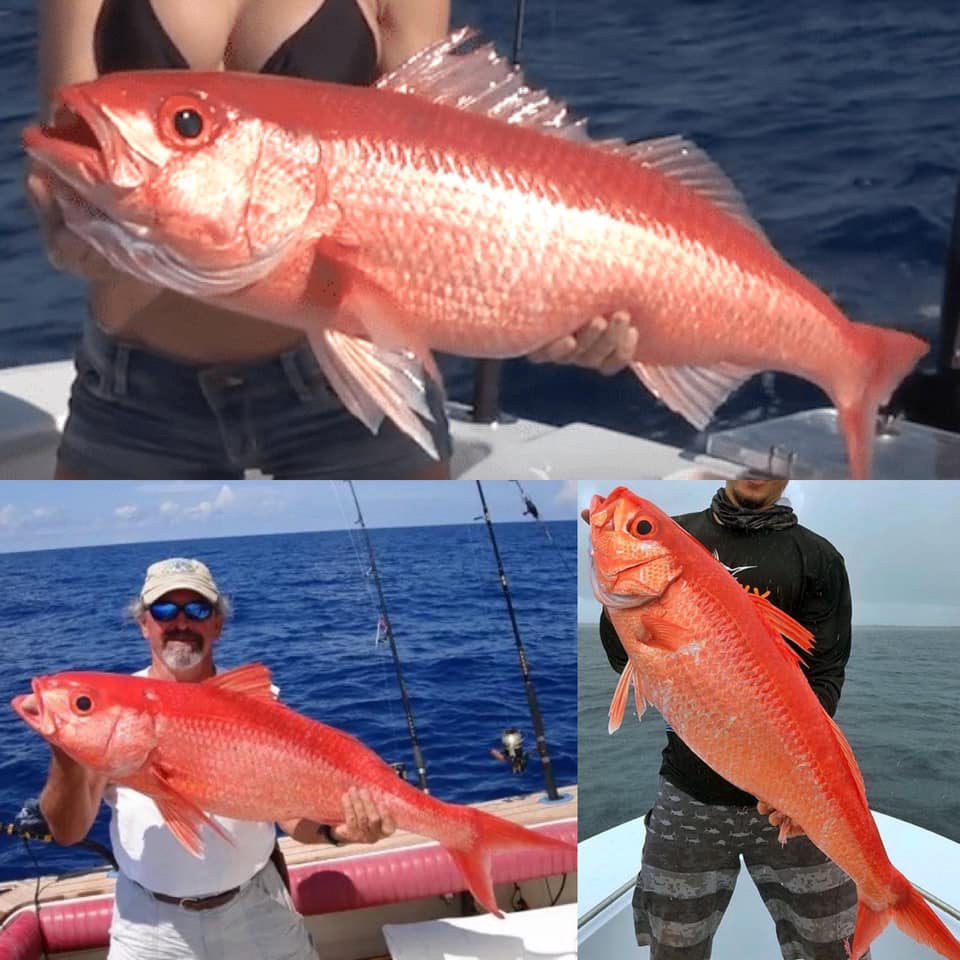By Sean Wilms/ Fish ID Jacksonville, FL
Photos by David Ronald Hartwell
This week we are going to cover a group of iconic fish in both inshore and offshore waters of the SE United States. So what exactly is a snapper? Snapper are fish that belong in the family Lutjanidae, and are characterized by primarily nocturnal, predatory fish that associated with coral reef, rock, concrete, oyster, and mangrove structures in their environment. Generally during the day they hide around their structure and in the evenings they actively ambush smaller fish in the open waters around the structure. The body style of snapper can vary somewhat but they all have notoriously strong mouths full of very sharp teeth and are known to actively snap their jaws shut repeatedly when out of the water as a defense mechanism. Most of snapper identification is achieved by looking at body shape and body and fin colors and patterns which may change somewhat from juveniles to adults.
I need to clear up one misconception before we get started. There are some fish that are called snappers that aren’t really snappers and will be excluded from my list. The most common example is the hogfish snapper, or hogfish. Despite their similarities in body shape and teeth, these fish are actually a wrasse, a totally different group of fish. Some fisherman also lump grunts in the same family as snapper. Despite similarities, grunts are also an entirely different family of fish (thankfully because there sure is a lot of them).
I’m going to go over the 13 species of snapper an inshore and offshore angler would want to know as they all have different regulations relating to minimum sizes, closed seasons, and bag limits. I did exclude one snapper on this list, the wenchman snapper. I did this because it’s only common in gulf and in very deep water, but please note that this is a potential species of snapper that could be caught as well. Please see the diagrams and photos below where I denoted whether they commonly occur offshore or inshore, or both.
Here’s the list of snappers we will cover:
- Mangrove Snapper (aka Grey Snapper)
- Lane Snapper
- Mutton Snapper
- Schoolmaster Snapper
- Mahogany Snapper
- Dog Snapper
- Cubera Snapper
- American Red Snapper
- Silk Snapper (aka Yelloweye Snapper)
- Blackfin Snapper
- Vermillion Snapper (aka Beeliner Snapper)
- Yellowtail Snapper
- Queen Snapper
Mangrove Snapper (aka Gray Snapper)Locations: common both inshore and offshore up to 80 FOW
Description: dark diagonal band through the eye on smaller individuals, fades in adults. tends to lack any bright coloration on body and fins except a thin blue stripe beneath eye sometimes present. Body color ranges from gray, to brown, to rusty red. Thin red margin on tail. May have lighter broken bars on body.
Medium sized fang-like incisors, only visible with mouth open. Sharp triangular head, rectangular body.
Size: common to 18 inches, maximum 24 inches.

Locations: common both inshore and offshore up to 130 FOW
Description: prominent large black spot underneath second dorsal fin, may fade in adults. Body color may be light blue, pink, or silver with broken horizontal bars that can be orange or yellow. Tail and dorsal fin are usually pink, orange, or red, pelvic and anal fin are always yellow.
Medium sized fang-like incisors, only visible with mouth open. Sharp triangular head, rectangular body.
Size: common to 12 inches, maximum 15 inches.

Locations: uncommon inshore, common offshore up to 150 FOW
Description: small black spot underneath second dorsal fin, may be absent in adults. Body color may be light blue, gold , or silver with possible faded vertical brown bars. All fins are red or pink.
Medium sized fang-like incisors, only visible with mouth open. Sharp triangular head, rectangular body.
Size: common to 24 inches, maximum 32 inches.

Locations: uncommon inshore, common offshore up to 80 FOW
Description: dark diagonal band through the eye on smaller individuals, fades in adults. Body usually silver, bright yellow, light brown, or bronze in color. Has a thin broken blue stripe beneath eye. All fins are always bright yellow. Prominent vertical thin lighter colored bars along the body.
Medium sized fang-like incisors, only visible with mouth open. Sharp triangular head, rectangular body.
Size: common to 18 inches, maximum 24 inches.

Locations: uncommon inshore, common offshore up to 120 FOW
Description: nearly identical to lane snapper as juveniles. large black spot underneath second dorsal fin, faded away in adults. Body color may be pink, rusty red, or silver with faded thin horizontal bars that can be orange or yellow, loose these as adults. Fins usually colorless or yellow with a prominent bright red margin on dorsal and caudal (tail) fin as adults.Medium sized fang-like incisors, only visible with mouth open. Sharp triangular head, rectangular body.
Size: common to 12 inches, maximum 15 inches.

Locations: uncommon inshore, common offshore up to 100 FOW
Description: prominent light triangular streak under the eye, looks like a tear streak at all sizes. tends to lack any bright coloration on body and fins except a thin broken blue stripe beneath eye always present. Body color ranges from gray, to brown, to yellow, orange, to rusty red. Fins usually yellow or orange. May have faded vertical bars of lighter color.
Medium sized fang-like incisors, only visible with mouth open. Sharp triangular head, rectangular body.
Size: common to 30 inches, maximum 36 inches.

Locations: uncommon inshore, common offshore up to 180 FOW
Description: Lacks any bright coloration on body and fins. Body color ranges from dark brown, to orange, to rusty red. Fins usually black, brown, or red. May have faded vertical bars of alternating light and dark color, more common in juveniles.
Large sized fang-like incisors, visible even with mouth closed. Sharp triangular head, rectangular body.
Size: common to 36 inches, maximum 60 inches.

Locations: only found offshore in 60-300 FOW
Description: prominent red eyes. Body color ranges from white to pink, or washed out red. Fins usually white or pink. Smaller individuals may have faded spot beneath second dorsal fin.
Medium sized fang-like incisors, only visible with mouth open. Sharp triangular head, rectangular body.
Size: common to 24 inches, maximum 36 inches.

Locations: only found offshore in 200-1000 FOW
Description: prominent yellow eyes. Body color ranges from white to pink, or washed out orange. Fins usually pink and yellow with dark margin in caudal fin.
Medium sized fang-like incisors, only visible with mouth open. Sharp triangular head, rectangular body.
Size: common to 20 inches, maximum 32 inches.
Locations: only found offshore in 20-300 FOW
Description: orange eyes. Body color ranges from yellow and white to brown as juveniles, to stark red and yellow as adults . Fins usually a mix of white, yellow, and red with a prominent black spot at the base of the pectoral fin that gives it its name. Tail and tail fin is always yellow, body can be white or red.
Medium sized fang-like incisors, only visible with mouth open. Sharp triangular head, rectangular body.
Size: common to 24 inches, maximum 30 inches.

Locations: only found offshore in 80-200 FOW
Description: red eyes. Body color ranges from white and pink to a washed out red . Fins are all a vibrant red or pink. Body many have broken horizontal yellow or brown lines. Small sized teeth, only visible with mouth open. Rounded head with elongated body.
Size: common to 20 inches, maximum 30 inches.

Locations: very uncommon inshore, found offshore up to 100 FOW
Description: yellow eyes. Body color is white and yellow, may turn pink on ice. Fins are all a vibrant yellow. Body usually has a horizontal yellow stripe leading to an all yellow tail, may have yellow spots on top of the body. Small sized teeth, only visible with mouth open. Rounded head with elongated body.
Size: common to 24 inches, maximum 32 inches.

Locations: only found offshore in 300-1000 FOW
Description: yellow eyes. Body color is pink or red. Fins are all a matching red. Caudal (tail) fin is extremely sharply forked with prominent elongated lobes. Small sized teeth, only visible with mouth open. Rounded head with very elongated body.
Size: common to 21 inches, maximum 36 inches.
I want to briefly discuss the American red snapper regulation problem since we are on the topic. Please note my intent of including this is not to change people’s minds and forcibly inject my ideas upon everyone else, but rather I would like to stimulate thought on the issue and help others think about problems from a different perspective.
A little background incase you are unfamiliar: the red snapper population decreased dramatically in past several decades mostly due to the increase in BOTH the commercial fishing effort for them as well as the huge increase in recreational effort on both of Florida’s coasts. Strict federal regulations with closed seasons were placed on the species; rarely opening up for only a couple days at a time each year on good years.
A lot of recreational fisherman in the Atlantic complain that the regulations are still far too strict there, yet the gulf gets much more relaxed open seasons. Fisherman in the Jacksonville – Port Canaveral area are especially vocal because red snapper is a common catch for many people in these areas, and on some reefs that is all people catch.
Jokes circulate about catching the ‘endangered red snapper’ but the reality is that the population AS A WHOLE remains a fraction of its historical numbers.
Please consider some facts about the American red snapper:
- Red snapper are not evenly distributed along the coasts. The Jacksonville area has a large amount of hard bottom reefs that extends over 70 miles off the coast in relatively shallow (less than 300ft). This is perfect red snapper habitat and there is a lot of it. The bulk of the population is in these waters. Compared to south Florida where the perfect red snapper habitat may end only 10 miles (or less) off the coast, there is significantly less individuals in those areas.
- The gulf has significantly different hard bottom habitats than the Atlantic and a drastically different bottom topography. Not surprisingly this means a different concentration of snapper.
- The gulf also has less people than the Atlantic. Less people means less fisherman which means less fish being caught, hence different regulations.
- Like all snapper, they associate with hard bottom reefs and wrecks, rarely moving from their territories except to spawn. This makes them easy targets for over fishing since they don’t move to avoid heavy fished areas (at least not very far).
- Snappers spawn in aggregations, massive schools offshore. Experienced fisherman can locate these spawning aggregation and easily wipe out large amounts of the largest most fecund (potentially reproductive) fish.
So what I want fisherman to take away from this is that the red snapper population problem is one of many many dimensions. Just because you can catch a boat load of them in Jacksonville doesn’t mean the population is near as numerous, and may actually be struggling in some other areas. Offshore bottom fish are particularly vulnerable to overfishing which is why most have strict regulations.
I will not pretend to say I believe the fisheries have been managed in the best way over the years, they certainly have not. But I just wanted to bring an appreciation to how difficult the task of fisheries management can be and to shed a new light on one of the problems most fisherman can relate too.

